Early Days
Today, thousands of people make their home in the modern community of Stepps, but in years gone by it was a rural area dominated by farms and woodland. The lands were once owned by a family called the Dunlops, before they were sold to the Sprot family in the early 1800s. The land remained in the Sprot family for generations, and it was under their tenure that the community of Stepps would steadily grow into a thriving commuter village in the railway age.

Ref: ‘Steps’ and Steps Road Station on a map from 1895.
It was a community that would come to be defined by the railway - even giving the place its name. The name Stepps does not appear on maps of the area before the railway was built, but in 1842 a station was opened there on the new Glasgow to Garnkirk railway. Local legend has it the station took its name, ‘Steps’, from the stepping stones which crossed a burn at that spot. The station was briefly renamed ‘Steps Road’ before, by 1924, becoming the ‘Stepps’ we are familiar with today.
The Coming of the Railway
Between the late 18th and early 19th century was a boom time for industry in central Scotland. The city of Glasgow was growing rapidly as people moved there from the country for work, and its own industries were developing exponentially. The need for raw materials - particularly coal and limestone - meant landowners nearby began developing their lands to exploit the natural resources beneath their feet.
Coal and limestone works were opened in the Stepps area around the time the lands were sold to the Sprot family. At the same time, the Monklands area further east (around modern-day Coatbridge and Airdrie) was rapidly developing as a coal mining area, as new technology - including steam engines - made it easier to mine the coal in large quantities.
It was this rapid development that would lead to the demand for transport to make it easier to move the coal into the city of Glasgow, to feed the thriving industry and growing population there. Mark Sprot and another local landowner, James Jeffray from nearby Cardowan, saw the potential to make money by giving over part of their lands to the proposed new Glasgow to Garnkirk railway. The track would be one of the first railway lines in Scotland, and the first to go directly into the centre of Glasgow. Mark Sprot was one of the railway’s main supporters and promoters, so much so that it was his wife, Harriet, who cut the first turf when work to lay the line commenced in 1827. The line went directly through Mark Sprot’s lands and would, over the coming decades, bring much change to the area that would become known as Stepps.
The railway opened in 1831 and transported coal and chemicals, linking up the city with the Monkland and Kirkintilloch railway. Soon, passenger services were added, and it was when the station opened at ‘Steps’ in 1842 that the area saw its first major development.
A Growing Community
The coming of the railway led to the first growth spurt of the community. Houses were built in the 1870s for railway workers, but other professionals would soon follow. Census records from 1881 list the occupations of Stepps residents as various railway workers (signalmen, platelayers and the station master), but also a wine merchant, shoemaker, grocer, lecturer, machinery merchant, joiner, and farmer.
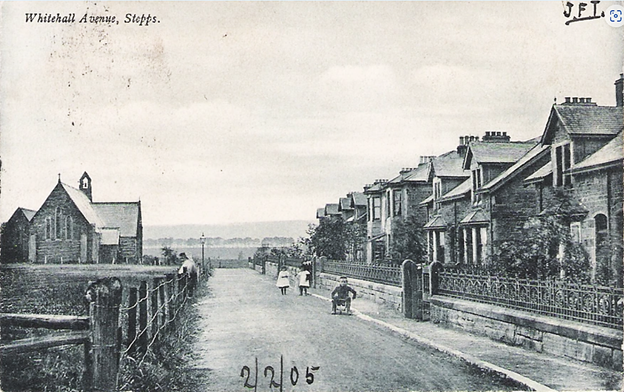
Ref: Whitehill Avenue, 1905. On the left is Stepps Parish Church, built 1900. Photo from Stepps Community Council Whitehill Avenue | Gallery (steppscc.com)
The community at this time, though growing, was still small. Local resident Jean Watson, writing in the 1990s when she was nearing 100 years old, remembered life as a child in Stepps at the turn of the century. She wrote:
Groups of houses, mainly villas and cottages, scattered about in West Ave, Cumbernauld Road, Whitehill Ave, half a dozen in Cardowan Road, Cardowan Drive, Lenzie Road and Whitehill Farm Road. There was no church, no school, no policeman. The Gamey (gamekeeper) was our only ‘Bogey Man’. There were only two shops - a tiny Post Office which also sold bottled sweets. There was no gas, no street lighting, the houses were lit by oil lamps. All public meetings were arranged where possible for moonlit nights, otherwise we carried storm lanterns.
Community Life and Church
The community at that time centred around the Union Hall, built on Cardowan Drive in 1885. With no school or church in the village, prayer meetings and social gatherings had up until then been held in railway workers’ kitchens or farmers’ barns. A committee of local residents raised funds to build the hall, which became a well-used local amenity, hosting meetings including church services and bible classes, a literary society, penny savings bank and singing classes. It even served as a school from 1888-1902.
The growing community meant an increasing need for facilities. While St Joseph’s Roman Catholic church had been built in nearby Cardowan in 1875, serving a catholic population of around a thousand from the surrounding villages, those wishing to attend Protestant church services had to travel to Hogganfield for Sunday worship.
The Union Hall became the home of church services, bible classes and Sunday school until the Established Church was built on Whitehill Avenue in 1900. This was followed six years later by the United Free Hall. The two congregations reflected the split in the Church of Scotland at the time, with opposing political views fracturing along the same lines as religious beliefs. As the U.F. Hall was opened in 1906, the Established Church was granted its own parish and became Stepps Parish Church. By 1913 the United Free congregation had built St Andrew’s United Free Church next door to the Hall on Blenheim Avenue.
In 1929 the United Free Church was reunited with the Church of Scotland. The former United Free congregation became St Andrew’s, and Stepps Parish Church became Whitehill Parish Church. This was until 1983 when St Andrew’s congregation had fallen to 300 and was no longer viable. The churches were amalgamated, St Andrew’s demolished and now home to a block of flats, Blenheim Court. The lintel stones from the main door of St Andrew’s Hall, reading “There I am in the midst” were rebuilt into the patio of Whitehill Church, which was renamed again Stepps Parish Church.
School
Before the Union Hall was built in 1885, the children of Stepps had to travel to Millerston, Auchinloch or Chryston to attend school. A young local woman, Miss Stenhouse, had been asked to start a school for the younger children in Stepps and, although only 19 and untrained, she proved to be a born teacher, and began taking lessons in the Union Hall.
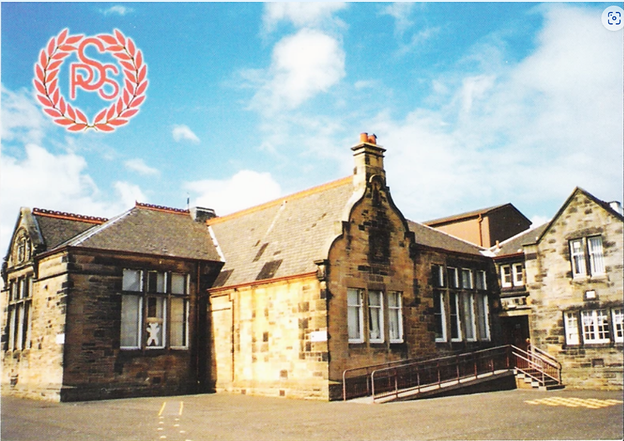
Ref: Original Stepps Primary School. Photo taken from Stepps Community Council Original Stepps Primary School / Gallery (steppscc.com)
With a growing population, the need arose for a dedicated school. Stepps Primary School was built in 1902 with space for 250 pupils, and Miss Stenhouse, who by this time had taken a teaching course, was to be its first teacher. Meanwhile, a dedicated Catholic primary school was established in Cardowan in 1901. An extension to the Stepps school was soon needed and opened in 1911 to accommodate another 300 pupils. The school continued to grow and by the 1970s temporary accommodation was introduced - which was to remain in place until a new school was built in 2007.
The new school was soon to face problems however as, having been built on boggy land, it suffered problems with subsidence and required remedial work. The attached cultural centre and library was forced to close, leaving Stepps without either facility - a situation that remains to this day. Discussions are currently underway to build a temporary library, but this is likely to be smaller than the original, and timescales for its construction remain unclear.
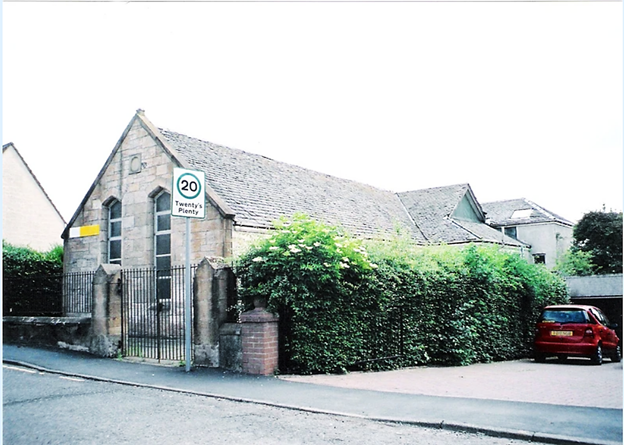
Ref: Union Hall. Photo taken from Stepps Community Council, Stepps Union Public Hall/ Gallery (steppscc.com)
The original Stepps Primary school, which had stood for more than 100 years and played an important part in the life of so many residents, was demolished in 2008.
The Union Hall, which had served as that early focal point of the community until the coming of separate churches and the school, survived for 122 years until it closed in 2007. It was also demolished in 2012.
The original Stepps Primary school, which had stood for more than 100 years and played an important part in the life of so many residents, was demolished in 2008.
The Union Hall, which had served as that early focal point of the community until the coming of separate churches and the school, survived for 122 years until it closed in 2007. It was also demolished in 2012.
A Commuter Suburb
The first years of the 20th century saw the community expand further, more than doubling its population from 576 in 1901 to 1,338 in 1911. At this time, the railway played an increasingly important part in the character of Stepps. The ease of travelling to Glasgow made many businessmen decide to move to the area to enjoy the peace and space afforded by a house in the country, with the convenience of commuting to their jobs in the city. In having one of the area’s earliest passenger railway stations, Stepps can fairly lay claim to being Glasgow’s first commuter suburb.
Stepps residents relied on the railway, and even with a regular service to Glasgow, they petitioned the Caledonian Railway Company for extra trains. They were successful in introducing a dinnertime service that enabled those who worked in Glasgow to return home to Stepps for lunch!
One group of regular commuters who met in the same train compartment every day, even formed a social club with an elected chairman. They named the club “Our Compartment”, and organised soirees and annual suppers throughout the 1910s for which they printed commemorative programmes.
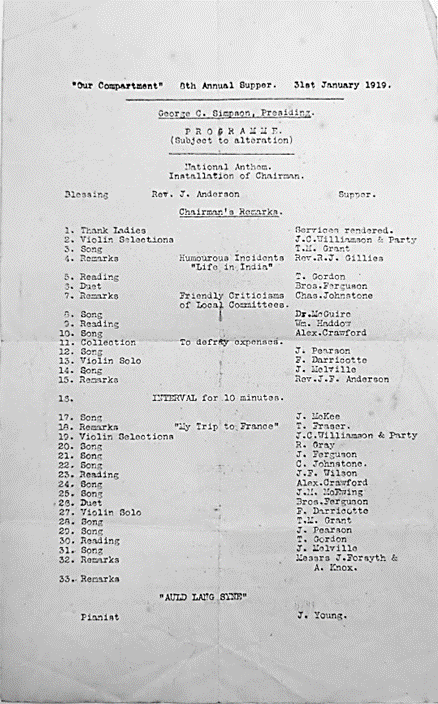
Ref: A programme for ‘Our Compartment’s annual supper, 1919. East Dunbartonshire Archives.
The trains were also used by schoolchildren going to senior school in Glasgow. In an interview conducted in 1986 with local resident Miss M Fraser, she remembers a steady stream of travellers heading into the city on weekday mornings:
There was [a train] at six o’clock went in and one at half past six. My father used to go in on the 7.15. And there was one at 8.14. Children who were going to school, the Glasgow school, went in at 8.14.
While the railway enabled Stepps residents to work in the city and enjoy country life at home, it was also the focal point for the social life of many residents. Not only did neighbours see each other every day on the busy services, they also got to meet extended families, as relatives living in the city would travel to Stepps for “a day in the country”.
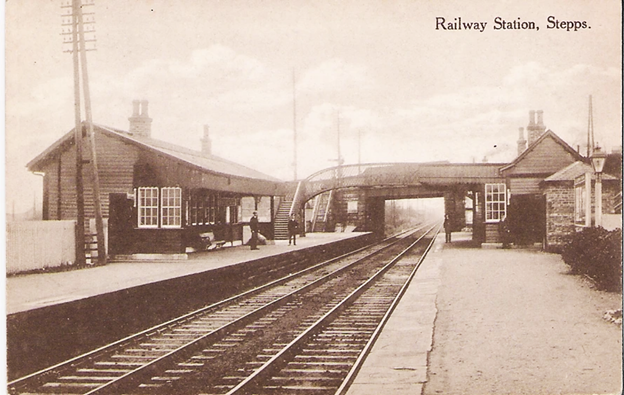
Ref: Original Stepps railway station. Photo taken from Stepps Community Council: Original Stepps Railway Station / Gallery (steppscc.com)
Local resident Ann McNeil, writing in 1981, remembers:
The trains were places where neighbours met going into town on business or pleasure, and so everyone knew each other and relations as well, for Stepps was country, and town folk came out for a day’s fresh air in the country. So, you would meet Aunt Bella, Auntie Jeanie or whoever either coming to Stepps in the afternoon or going back to town in the evening. And believe me, the station platform was a busy place before the last train passed out of the station.
Leisure
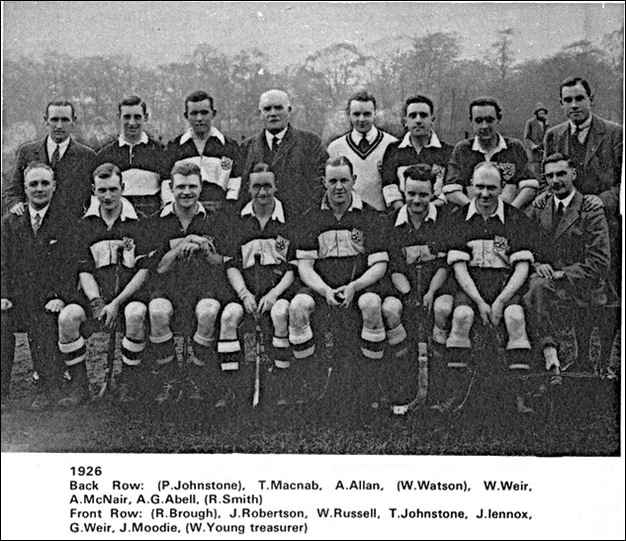
Ref: Stepps Hockey Club in 1926. Photo taken from Stepps Hockey Club.
https://www.steppshockey.co.uk/history?lightbox=c73u
The first decades of the twentieth century also saw a growth in social and leisure life of the community. Alongside the churches, groups for young people were established, with the Boys’ Brigade in 1907, Scout troop in 1914, and later, in 1921, Girl Guides. Sports clubs also sprang up, with golf and cricket clubs opened in the 1900s, a bowling club in 1905, the Stepps Lawn Tennis Club 1908, and the hockey club in 1913.
The hockey club would go on to become one of the features for which Stepps would be most well-known. Founded at a time when the craze for the relatively new game of hockey saw clubs opening all over the country, over the course of its 110-year history, the club has produced ten senior internationalists, two of whom played for Great Britain, one under-23 internationalist, and four under-21 Internationalists. The club, which was for several decades based at the pitch behind the current primary school, since the 1990s trains and plays at pitches owned by Strathclyde University just a short hop down Cumbernauld Road in Millerston.
First World War
While the community was steadily growing in the early years of the 20th century, the outbreak of war in 1914 came as a shock to what was still a relatively small, quiet village. Ann McNeil remembered:
A newspaper boy came out from town and ran round the village ‘war declared’. This on a Sunday morning when there was never a sound other than cows mooing and birds signing. Everyone rushed out to buy a paper and that showed how serious it was, for a lot of people did not approve of Sunday papers and did not buy them. A great many people walked into the City Chambers in Glasgow to hear if the news was really true - no wireless, television, and few telephones, so no instant news. It was all too true and our boys in the village had calling up papers in no time and had little training before being sent to France.
Sadly, many young Stepps men lost their lives in the conflict, including Andrew Montgomery, killed aged 23 on the first day of the Battle of the Somme, and brothers Thomas and James Colvin, killed two weeks apart in 1918. Thomas had been a ticket collector at Stepps railway station.
The war was also a difficult time for the local postmistress, Trudy Swart, whose family had moved to Stepps in the 1890s from Holland. The Swarts had set up the local postal service when they arrived, eventually building a new house and shop which they named ‘Groningen’ after their home town. Trudy would go on to run the Post Office in Stepps for 51 years. With the village postman, Anthony Gray, away during the war, Stepps residents had to go to the Post Office to pick up their letters. Ann McNeil remembers Trudy “had a sad time…when so many telegrams came bearing sad news from the front.” Further sadness would come when the news of Anthony Gray’s death reached home in 1917. He was 29.
Following the war, a memorial to those who lost their lives was erected at the corner of Blenheim Road. It remained here until 1953 when it was moved to its present site in the park on Cumbernauld Road.
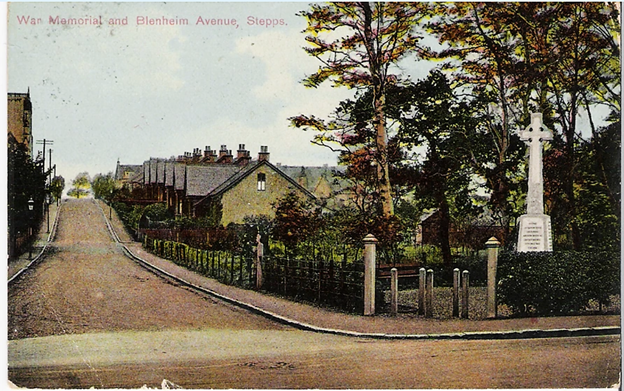
Ref: Photo taken from Stepps Community Council: War Memorial and Blenheim Avenue / Gallery (steppscc.com)
Shops
The period between the two world wars saw Stepps develop into a thriving suburb. Between 1918 and 1952, 224 new homes were built in Stepps, in a push by Lanarkshire County Council to increase the population of the area.
At a time when fridges were not yet commonplace in many homes, Stepps was home to a wide variety of shops serving customers who had to buy provisions on a daily basis. In the 1950s this included the Post Office, butcher, draper, fish shop, a pharmacy based at the doctor’s surgery (later a ladies’ and childrenswear shop), fruit shop, sweet shop, baker, newsagent and stationer, cobbler, ice cream shop, coal merchant, four or five grocers, plus the Shettleston Co-op on Cumbernauld Road.
Writing in 2004, local resident Campbell Provan remembered the shops of his youth in the 1940s and 50s and paints a vivid picture of life in the community at that time:
The butcher… had white tiled walls and half cows and other pieces of meat hanging from chrome plated hooks and rails. The Health and Safety inspectors would have something to say today. My brother Alan used to deliver butcher meat, by bicycle, for Willie McFarlane on a Saturday morning.
The fish shop run by Robert Moffat had a large terrazzo slab at the front, covered in fish and the window always raised. The fish were gutted on the premises, by Mary Baker. There was a large sink where the tap always seemed to be running.
[In the fruit shop] the fruit was in wooden boxes, potatoes in bags and carrots, turnips etc lying in trays. Nothing washed or prepacked. Most fruit and vegetables were only available "in season" and not all year round. Families eagerly awaited the arrival of Scotch tomatoes and raspberries and strawberries.
The sweet shop was run by Mrs Prentice until her death in 1951. Visiting her was a treat as sweets were still rationed until 1953 and coupons had to be cut from the ration book. The sweets were loose in large glass jars and weighed and sold in paper bags. Difficult choices had to be made in this shop.
The next shop was a grocer run by Irvine McNish. Until the late 1950s this was a typical grocer of the time with a counter and assistants. Everything had to be asked for, no picking up your own items. All goods were on shelves behind the counter. Cheese was cut on a marble slab with a wire cutter, butter was taken from what seemed like a mountain with wooden paddles and patted into shape and then wrapped. The paddles had to be kept wet. Ham was cut on a large red machine with a vicious blade that sat on the counter beside the scales. Sugar came loose and had to be weighed into thick blue paper bags. It wasn't until 1956 that self-service shops began springing up across the country.
[There was also] the Belvedere Cafe known to everyone as Tony's. Latterly Tony Faccenda had a van and used to come round the village selling ice cream. Everyone knew Tony.
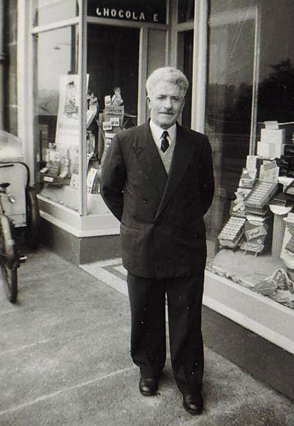
Tony Faccenda outside his cafe in the 1960s.
View on Facebook
Sadly, the community has since lost most of these small local stores as shopping habits have changed and large supermarkets taken precedence. Stepps was reminded of its bustling community heyday in 2021 when local restaurant Real Spice was updating its signage and uncovered the original Tony’s Cafe sign beneath, revealing a hidden history that evoked a flood of memories from those who had spent many a happy hour in this Stepps institution.
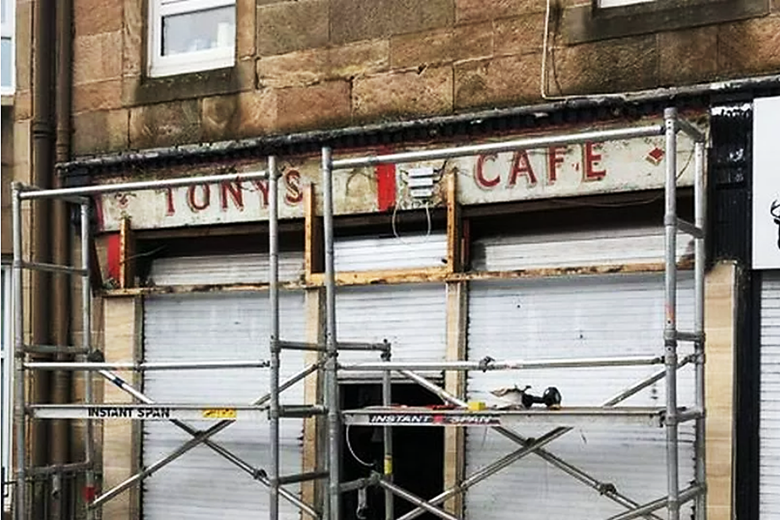
Ref: Original Tony’s Cafe sign beneath the frontage of Real Spice. Image.
https://www.glasgowlive.co.uk/news/glasgow-news/stepps-indian-restaurant-find-vintage-19916609
Transport
Alongside the population boom in Stepps in the first half of the 20th century came an increase in traffic, as more residents bought private motor cars. What had once been a railway commuter village was now increasingly becoming a car-owning village as Stepps residents took to this new mode of transport.
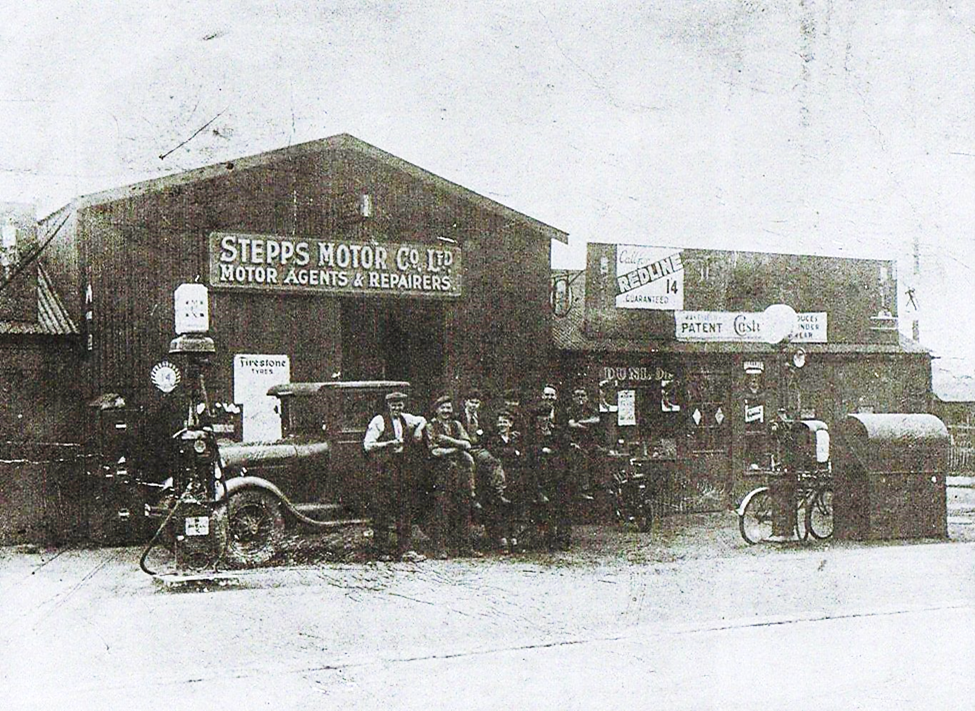
Ref: The Stepps Motor Company, 1936.
View on Facebook
Car traffic would take even more precedence in Stepps when the railway station, which had served the community for more than a hundred years, closed in 1962.
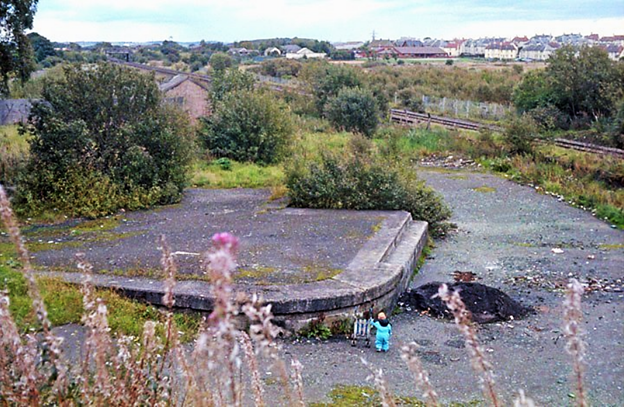
Ref: Site of the first Stepps station, closed in 1962 and built over with houses in the 1990s.
https://www.railscot.co.uk/img/52/243/
Edoardo Ceresa moved to Stepps after finishing his university studies, to open a pharmacy in the area. He remembers his first impressions of the community in the 1970s:
Very village like, very quiet, population wasn’t what it is today. It had no pharmacies which was one of the reasons why I was attracted to Stepps. It had one doctor, not very many shops although the shops are all changed now, at that time you had the butchers, baker, fish shop, now it’s all completely different.
By the 1980s, traffic through Stepps had become a problem, with the main road choked with traffic and lorries which had no choice but to drive through the village when travelling between Glasgow and Cumbernauld (which had grown rapidly since being designated a New Town in 1955).
Edoardo remembers:
At one time it was a four-carriage way that went through Stepps, people didn’t have a chance to stop cause you couldn’t cross the road basically.
Plans for a bypass to divert traffic away from Stepps had originally been envisioned during the planning of the M8 motorway in the 1960s, but it would take until the 1990s for construction to begin. The first phase of the new road, the M80, officially opened on 8 June 1992 and diverted traffic away from Stepps as far as the roundabout at the east end of the town, where cars would rejoin the old Cumbernauld road on its route north. In 1996, consultation began on extending this route to finish the M80 - a project which was finally completed in 2011.
After being without a railway station for 27 years, passenger trains would return to Stepps with the opening of a new station, slightly further east along the line, in 1989. Stepps station is once again as busy as it was in its early days, with up to 67 trains a day running through between Glasgow Queen Street and Cumbernauld or Falkirk Grahamston.
Industry
While Stepps has largely been known as a commuter town, with industry based elsewhere, if never that far (such as the colliery in next door Cardowan, half a mile away), in the 1960s the community became home to the blending and bottling complex of J Buchanan & Co whisky. At one time, 1,000 people were employed at the plant, including personnel moved up from the firm’s London office. The plant was partly fuelled by methane tapped from the Cardowan pit.
The main feature of the works, a 10-story administration block, came to be known as the “Black and White Tower” after the firm’s most popular brand of whisky. The tower, a recognisable landmark, still dominates the Stepps skyline today.
The plant remained in production until 1987 when it was closed by Guinness, the owners at the time. The site is now occupied by the Buchanan Business Park, and is also home to the Pioneer Film Studio, established in 2022, which markets itself on the back of the site’s whisky-based history and makes use of the expansive space of the former bottling plant.
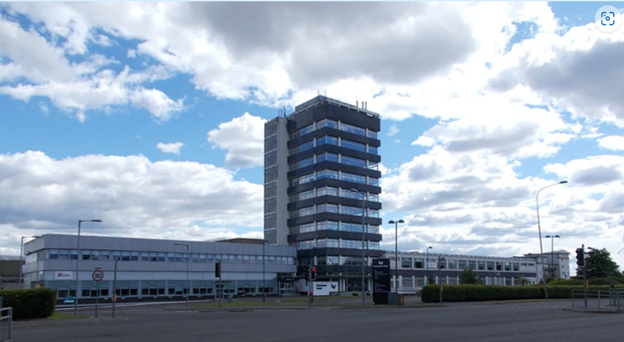
Ref: ‘Black and White’ tower. Photo: Stepps Community Council.
Black & White Tower / Gallery (steppscc.com)
A Border Community
As well as the railway, the character of Stepps has been affected by its location at the boundary of local government districts.
Historically part of the County of Lanark, in 1975 it became part of Strathkelvin, an area which also took in Bishopbriggs and Kirkintilloch, creating a close association with these towns. When local government boundaries were again reorganised again in 1996, Stepps was incorporated into North Lanarkshire, consolidating its association with towns to the east rather than the west.
Being so close to the border with Glasgow City Council has created unexpected consequences for residents, with young families moving into new housing developments in Cardowan, which lie directly on the border, unhappy when their children were placed in Glasgow schools in Easterhouse rather than the closer Stepps school. Others have reported frustration accessing council services when their ‘G’ (Glasgow) postcodes are not recognised by automatic systems as belonging to North Lanarkshire.
Stepps Today
More recent times have seen the population of Stepps continue to grow, with large new housing developments built in the area.
The new developments have not always been welcome, particularly with the strain they place on local infrastructure and amenities, and increasing demand for school places. Edoardo Ceresa still lives in Stepps and shared his thoughts on the effect of population growth on the community:
Especially in the last 20 years, when the population of Stepps has gone from about 5,000, almost doubled, and I’m gonna say almost doubled, will be over 8,000 once the new buildings are all in place, influx of new people. I think the community in some way have actually torn apart, rather than come closer together. The schools I think have got a big influence on community life in bringing the primary schools that we have, we have got two primary schools, we’ve got St Joseph’s and Stepps Primary and they certainly help to bring a cohesiveness to the community which is a good thing.
Edoardo is active in Stepps Community Council, which has over recent years campaigned to maintain green space in the community, in the face of increasing housebuilding which has threatened to dominate the environment:
We’ve lost a lot of green space, but we still have quite a bit of green space which should be maintained. Which is why the Community Council is quite forceful in trying to control the building of… The latest build, where the Cala Homes are, Earl’s Rise, was a farm - the farm’s gone now. Now we’ve got 200 houses, so we’ve lost that. The builders to a small degree are trying to keep - well, with pressure from the Community Council - to keep some trees and all the rest of it going. So, we’re trying to keep some ecology in the place, rather than just have concrete all over the place.
With the new houses near completion, people are attracted to Stepps as they were 150 years ago by its good transport links to Glasgow. Having been transformed from a rural estate owned by one family, to a small community of just a few houses in the mid-19th century, Stepps is now home to more than 7,500 people. Time will tell what the future holds for this ever-evolving community.
N.B. With sincere thanks to Stepps residents Campbell Provan and Freda Bunyan for sharing their extensive knowledge of Stepps’ history and contributing materials to this chapter.






